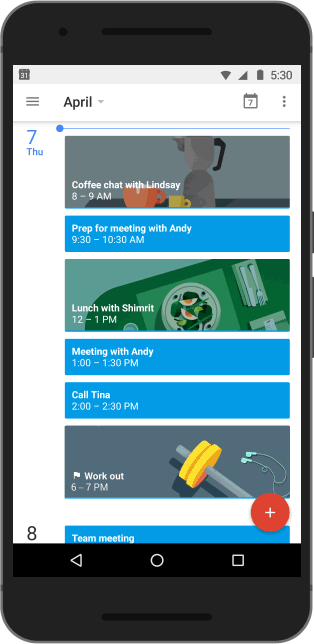Come risolvere i problemi delle pulizie domestiche con Samsung Powerbot TURBO
 Primavera senza pensieri con Samsung, in arrivo il nuovo Powerbot TURBO. Connettività, massima forza aspirante e un design elegante rendono il nuovo Powerbot il miglior alleato per le pulizie domestiche Con l’arrivo della primavera arriva anche la voglia di evadere dalla città, godersi al meglio il tempo libero con la famiglia o con gli amici, […]
Primavera senza pensieri con Samsung, in arrivo il nuovo Powerbot TURBO. Connettività, massima forza aspirante e un design elegante rendono il nuovo Powerbot il miglior alleato per le pulizie domestiche Con l’arrivo della primavera arriva anche la voglia di evadere dalla città, godersi al meglio il tempo libero con la famiglia o con gli amici, […]
Estonian Design alla Milan Design Week
 Entrare nel cuore della creatività e del design estone, abbracciando tutti i settori dell’ Estonian Design House, è un’esperienza nuova per milanesi e visitatori della Milan Design Week 2016. Accessori di moda, mobili, illuminazione, vetro, lampade, gioielli. Non solo con ottimi risultati qualitativi, ma anche spesso nel rispetto dei temi della sostenibilità e dell’innovazione tecnologica. […]
Entrare nel cuore della creatività e del design estone, abbracciando tutti i settori dell’ Estonian Design House, è un’esperienza nuova per milanesi e visitatori della Milan Design Week 2016. Accessori di moda, mobili, illuminazione, vetro, lampade, gioielli. Non solo con ottimi risultati qualitativi, ma anche spesso nel rispetto dei temi della sostenibilità e dell’innovazione tecnologica. […]
Kindle Oasis: nuovo e più leggero di sempre
 Kindle Oasis: il Kindle più sottile e leggero di sempre Progettato per offrire la sensazione dell’assenza di peso, Kindle Oasis è incredibilmente sottile e dotato di un’impugnatura ergonomica che sposta il centro di gravità nel palmo della mano, creando un bilanciamento perfetto che consente di leggere comodamente per ore con una sola mano. Kindle Oasis […]
Kindle Oasis: il Kindle più sottile e leggero di sempre Progettato per offrire la sensazione dell’assenza di peso, Kindle Oasis è incredibilmente sottile e dotato di un’impugnatura ergonomica che sposta il centro di gravità nel palmo della mano, creando un bilanciamento perfetto che consente di leggere comodamente per ore con una sola mano. Kindle Oasis […]
Italiani scontenti, impossibili i micropagamenti: la ricerca di Jusp e Doxa
 Gli italiani vogliono avere la libertà di effettuare anche i micro pagamenti con le carte Lo rivela un’indagine condotta da Doxa per conto di JUSP Quasi due terzi del campione intervistato che utilizza le carte elettroniche è favorevole alle sanzioni relative all’obbligo di esercenti e professionisti di accettare le carte senza limiti di importo La […]
Gli italiani vogliono avere la libertà di effettuare anche i micro pagamenti con le carte Lo rivela un’indagine condotta da Doxa per conto di JUSP Quasi due terzi del campione intervistato che utilizza le carte elettroniche è favorevole alle sanzioni relative all’obbligo di esercenti e professionisti di accettare le carte senza limiti di importo La […]
Google Calendar vi aiuta a raggiungere i vostri obiettivi
Che sia leggere più libri, imparare una lingua straniera o andare in palestra regolarmente, raggiungere degli obiettivi può essere davvero difficile. Una volta perchè c’è una riunione dell’ultimo minuto, un’altra perchè c’è un amico in città. Senza che ve ne rendiate conto, i vostri obiettivi passano in secondo piano o, addirittura, svaniscono. Con tutto quello che c’è da fare, è sempre più difficile trovare il tempo necessario, anche quando l’obiettivo è molto importante.
Ecco perché oggi presentiamo gli Obiettivi di Google Calendar. Basta inserire il vostro obiettivo personale – per esempio “correre 3 volte alla settimana” – e Calendar vi aiuterà a trovare il tempo per farlo.
Gli obiettivi sono facili da impostare
Se l’obiettivo è, ad esempio, fare più esercizio fisico, dovrete solo rispondere ad alcune domande e Calendar farà tutto il resto. Valuterà i vostri impegni e proporrà un calendario di allenamenti in base alle vostre risposte.
Gli obiettivi si adattano ai vostri impegni
Raggiungere un obiettivo non è facile, soprattutto quando si presenta un imprevisto. Ma Calendar è pronto ad aiutarvi e rimanderà automaticamente il vostro obiettivo se si verificano più eventi in contemporanea.
Potete anche usare l’opzione Rinvia per chiedere a Calendar di cambiare la pianificazione.
Ricordate che Calendar migliora nella pianificazione degli obiettivi man mano che lo usate: quindi posticipate, modificate o completate i vostri obiettivi normalmente, e Calendar farà sempre meglio la prossima volta.
Calendar può aiutarvi a organizzare al meglio il vostro tempo, non soltanto a organizzare gli impegni. E oggi che Calendar compie 10 anni (🎉), siamo ancora più entusiasti di investire in sempre più aggiornamenti come Obiettivi e aiutarvi a trovare il tempo per tutto ciò che conta per voi, che sia un promemoria, più esercizio o semplicemente un po’ di tempo per voi.
Per cominciare, scaricate l’app Google Calendar su Android o iPhone e impostate il vostro primo obiettivo.
Scritto da: Jyoti Ramnath, Product Manager
Spider-Man: Homecoming – Ecco il titolo del nuovo film su Spider-Man
 La nuova avventura cinematografica dell’Uomo Ragno si intitolerà Spider-Man: Homecoming La Sony Pictures ha svelato durante il CinemaCon il titolo della nuova avventura cinematografica dell’Uomo Ragno. Il film si intitolerà Spider-Man: Homecoming, un riferimento sia all’evento scolastico (quando licei e università celebrano il ritorno di studenti ed ex studenti con una grande festa, solitamente in […]
La nuova avventura cinematografica dell’Uomo Ragno si intitolerà Spider-Man: Homecoming La Sony Pictures ha svelato durante il CinemaCon il titolo della nuova avventura cinematografica dell’Uomo Ragno. Il film si intitolerà Spider-Man: Homecoming, un riferimento sia all’evento scolastico (quando licei e università celebrano il ritorno di studenti ed ex studenti con una grande festa, solitamente in […]
Nuove spettacolari clip per Captain America: Civil War
 Nuove clip per Captain America: Civil War, il film che inaugura la Fase 3 della Marvel. Nuove clip per Captain America: Civil War, il film diretto da Anthony e Joe Russo, in arrivo a maggio 2016. Il primo video è stato mostrato durante gli MTV Movie Awards e vede come protagonisti Capitan America (Chris Evans), […]
Nuove clip per Captain America: Civil War, il film che inaugura la Fase 3 della Marvel. Nuove clip per Captain America: Civil War, il film diretto da Anthony e Joe Russo, in arrivo a maggio 2016. Il primo video è stato mostrato durante gli MTV Movie Awards e vede come protagonisti Capitan America (Chris Evans), […]
Nuovo Acer Iconia Tab 10
![]() Gli altoparlanti frontali Acer Quadio, con tecnologia DTS-HD Premium Sound® migliorano la definizione sonora e il volume, forniscono un suono virtual surround Pulsante MediaMaster per selezionare le migliori impostazioni A/V nei diversi scenari di utilizzo Touchscreen Acer Precision Plus, 2,5 volte più sensibile rispetto ai pannelli normali Uscita Micro HDMI e compatibilità Wireless Display per […]
Gli altoparlanti frontali Acer Quadio, con tecnologia DTS-HD Premium Sound® migliorano la definizione sonora e il volume, forniscono un suono virtual surround Pulsante MediaMaster per selezionare le migliori impostazioni A/V nei diversi scenari di utilizzo Touchscreen Acer Precision Plus, 2,5 volte più sensibile rispetto ai pannelli normali Uscita Micro HDMI e compatibilità Wireless Display per […]
Benedict Cumberbatch nel primo spettacolare trailer di Doctor Strange
 Benedict Cumberbatch protagonista del primo spettacolare trailer del cinecomic Marvel Doctor Strange. La Marvel ha finalmente diffuso il primo trailer di Doctor Strange, il cinecomic con protagonista Benedict Cumberbatch, nel ruolo di Stephen Strange. Diretto da Scott Derrickson (Sinister), Doctor Strange vede nel cast Benedict Cumberbatch, Tilda Swinton, Chiwetel Ejiofor e Mads Mikkelsen. L’uscita è […]
Benedict Cumberbatch protagonista del primo spettacolare trailer del cinecomic Marvel Doctor Strange. La Marvel ha finalmente diffuso il primo trailer di Doctor Strange, il cinecomic con protagonista Benedict Cumberbatch, nel ruolo di Stephen Strange. Diretto da Scott Derrickson (Sinister), Doctor Strange vede nel cast Benedict Cumberbatch, Tilda Swinton, Chiwetel Ejiofor e Mads Mikkelsen. L’uscita è […]
AVM e lo stato dell’arte delle connessioni LTE
In questo articolo ci concentreremo soprattutto sulle tecniche di trasmissione legate a LTE, ma cureremo anche la parte wi-fi e valuteremo gli sviluppi futuri. Per andare più in profondità abbiamo contattato due esperti di AVM, Flavio Patria e Tom Vierke.
L’adrenalina raggiunge livelli incredibili nella prima clip di Hardcore!
 Arriverà nelle nostre sale il 14 aprile 2016, distribuito da Lucky Red, Hardcore! Ecco la prima clip in italiano. Diamo un’occhiata alla prima clip di Hardcore!, l’action movie in prima persona diretto da Ilya Naishuller. Nel cast del film troviamo Haley Bennet, Danila Kozlovsky, Sharlto Copley (District 9), Andrey Dementiev, Dasha Charusa e Sveta Ustinova. […]
Arriverà nelle nostre sale il 14 aprile 2016, distribuito da Lucky Red, Hardcore! Ecco la prima clip in italiano. Diamo un’occhiata alla prima clip di Hardcore!, l’action movie in prima persona diretto da Ilya Naishuller. Nel cast del film troviamo Haley Bennet, Danila Kozlovsky, Sharlto Copley (District 9), Andrey Dementiev, Dasha Charusa e Sveta Ustinova. […]
Quanto varia il significato di un’emoji da piattaforma a piattaforma
Ogni piattaforma ha delle proprie emoji. Seppure queste siano realizzate seguendo le linee guida rilasciate da Unicode, variano molto nello stile e nell’implementazione causando così interpretazioni e letture inaspettate. Mettiamo che abbiate inviato, dal vostro iPhone a un vostro amico che usa Android, la faccia sogghignante con occhi sorridenti (😁): l’impressione che avrà sarà probabilmente diversa da quella che volevate […]
Cassetteboy contro lo Snooper Charter
Lo Snooper Charter è una proposta di legge del Segretario di Stato Theresa May che obbligherebbe gli operatori telefonici e i produttori di smartphone che operano in Inghilterra a mantenere per 12 mesi un archivio del traffico dati degli utenti, delle email inviate, delle comunicazioni avvenute sui social network e delle chiamate effettuate e ricevute.
Le novità di Asus presentate alla #mdw2016 #glowoflife
 Milano Design Week 2016 – ASUS presenta una serie di innovazioni ispirate alla filosofia Zen La completa gamma di prodotti consumer mette in evidenza un’etica progettuale che pone sempre al centro le nostre vite quotidiane per regalare a ciascuno esperienze avvincenti. ASUS Design Center, il prestigioso e pluripremiato gruppo di designer di ASUS, presenta l’evento […]
Milano Design Week 2016 – ASUS presenta una serie di innovazioni ispirate alla filosofia Zen La completa gamma di prodotti consumer mette in evidenza un’etica progettuale che pone sempre al centro le nostre vite quotidiane per regalare a ciascuno esperienze avvincenti. ASUS Design Center, il prestigioso e pluripremiato gruppo di designer di ASUS, presenta l’evento […]
Rovinare un matrimonio con la condivisione di informazioni sui social network
 Indagine Kaspersky Lab: la condivisione di informazioni online può rovinare carriere e matrimoni Secondo un’indagine condotta da Kaspersky Lab, gli utenti continuano a condividere con noncuranza informazioni private su Internet in situazioni pericolose. Il 28% degli intervistati condivide informazioni confidenziali per errore, mentre il 16% svela intenzionalmente segreti personali, nonostante il pericolo che le informazioni […]
Indagine Kaspersky Lab: la condivisione di informazioni online può rovinare carriere e matrimoni Secondo un’indagine condotta da Kaspersky Lab, gli utenti continuano a condividere con noncuranza informazioni private su Internet in situazioni pericolose. Il 28% degli intervistati condivide informazioni confidenziali per errore, mentre il 16% svela intenzionalmente segreti personali, nonostante il pericolo che le informazioni […]






